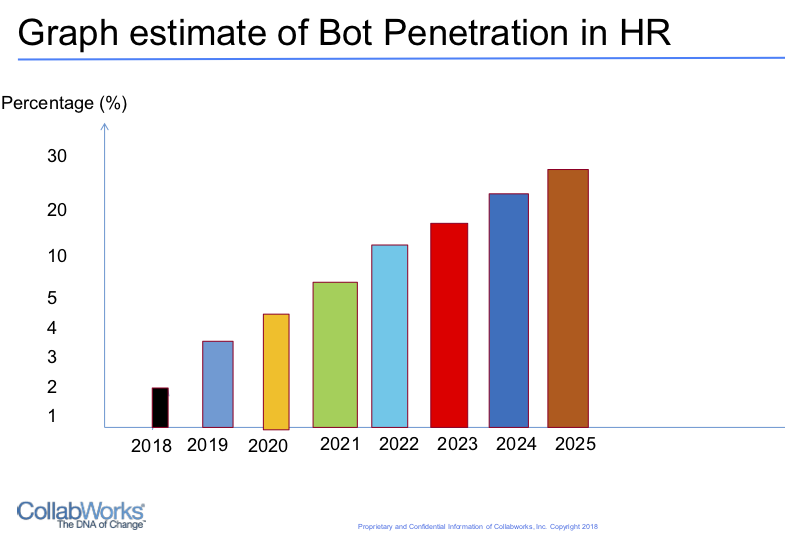Over the last 6 months we quietly investigated the nature of work (which is rapidly changing) and how to better manage it. We have done this in a very logical way, by collecting assessment data from HR groups in 4 different companies (most from different industries), and analyzing that data
What we found was quite interesting, in that most companies are not managing work, but rather managing workers. To ensure that the staff can produce the expected results, most firms are actively working on making the entire process as seamless and as easy as possible. With health screenings (dig this information here), paid leaves, hybrid models, and work flexibility, employees are at an added advantage to bring their best talents to their organization. Considering the coming wave of automation, we also investigated how bots (find out what is a bot) could be integrated into HR in the least disruptive way possible.
The same is true in the case of the healthcare industry as well. They tend to hire external parties to manage claim issues and underpayment patterns in hospital claims in order to effectively manage their revenue cycle. These vendors typically employ cutting-edge METIS software to benefit their hospital partners and the patients they serve. Every year, healthcare providers lose millions due to denied and underpaid claims. Unfortunately, most providers lack the time, staff, or ability to follow up, resolve issues, and receive proper payouts in order to keep the books balanced and revenue streams intact. This could be one of the reasons why hospitals require the assistance of these vendors who use automated technology to do Revenue Cycle Management intelligently. So, whether directly or indirectly, it can be concluded that automation is now a part of almost every industry.
The methodology of analyzing the data and keeping a track of revenue was to do both primary and secondary research on bot vendors and users, and start to correlate that with the HR assessments. What emerged was some startling revelations about the nature of work, how and where to automate with the lowest level of disruption, and how bots will be needed to help deal with the gender bias issue that is plaguing management of many companies worldwide.
Managing Work
If you are an executive today, you are managing headcount. In many cases, managers are not clear about what those that report to them do on a daily basis? Our initial assessments, which we think are similar to those at Tilt 365, and we keep refining, show exactly what tasks people do, and what % of their time it takes to do them.
Some of these results were surprising, even to those completing the assessment. For simplicity, let’s divide the tasks into three types. “X” level work: tasks that are repetitive, doesn’t require much thought or creativity, and are not helping to build an employees skills or growth at the company. “Y” level work: which may be somewhat repetitive, but do require some thought and creativity, and can help build new skills for the employee. “Z” level work: which is challenging, creative, and often stretches the employee in terms of both skills and collaboration.
The goal in managing work effectively, is to have Z level workers (who get paid Z level salary), do mostly Z level work (tasks). When I asked the CEO of a small collaboration software company “How much time each day do you spend in meetings?” He replied “about 2/3 of my time each day.” I then asked, how much of that time in meetings are you doing Z-level work? His answer was about 5%. The next time we talked, he had eliminated half of his meetings and was doing more work with the product and sales teams in interacting with large accounts.
Our Research
Others, doing research similar to ours have found that:
- “While 72% of respondents see AI as important, only 31% are ready to deal with it.” Josh Bersin, AI, Robotics and automation – Deloitte Insights.
- HR managers spend 14-30 hours/week doing mundane, repetitive tasks (CareerBuilder)
- Bots can answer 50% of employee questions (Parl.io)
- Average time savings per chatbot inquiry is 4+ minutes (Juniper Research)
- Obie (Slackbot, Dashbot platform) providing workplace information to employees: Who, What, When, Where, How? Changed on-boarding from account creation, to an interactive employee discovery process. > 3 months, on-boarding engagement increased 40%.
- Bots can save 20%-40% of time on sourcing candidates (Ubisend, Leforce)
- Improve recruiter efficiency 24% – 38% (Montage, FirstJob)
- A VCV bot was able to cut the total time to recruit from 250 CVs to 3 meetings with the hiring manager. From 21 hours, to 45 minutes.
We found that:
- By automating specific processes with bots will save 11% FTE by 2020 and 24% FTE by 2022.
- The primary services subject to bot improvement (in HR) are: recruiting, employee experience, and talent management
- Repetitive communications around processes and data can be automated, thus reducing FTE, cycle time, while improving quality
- By relieving repetitive tasks, the HR talent can shift to providing a more personalized service
- Bot implementation requires clarity about the service and customer needs, and a clear process for implementation
While others had predicted bot savings, we are the only ones to have actual data analysis to back up our findings. Our analysis methodology was to:
- Three data sets used: 3 HR departments assessed (almost 200 people)
- Created a complete activities list
- Matched specific tasks with vendors and bot case studies to estimate bot ability to do those tasks
- Matched activities to bot solutions, estimated what % of activity could be done by bots, looked at today, 2 years out, 4 years out
- Aggregated the results across each organization (looking at potential leverage by bots in each organization, and each time frame)
- Examined benefits from bots in specific case studies
Based on our analysis, bots will slowly, (but steadily) become part of normal HR processes,
We also did an estimate of bot revenues in the Forbes 2000 based on our 2021 estimate of 7% bot penetration.

Our Report
The report, written from this research, goes into much greater detail, than the few results we have briefly discussed in this executive summary. We believe the benefits of this report to client companies will include:
- The ability to better manage work, and use employees more effectively
- Understanding when and where to apply bots or contingent workers to maximize revenue
- How to use CollabWorks to better morale and engagement, support better self management, and increase employee effectiveness.
- To get a better handle on what each employee does for their job, and provide a growth path for them with the company.
- Increase employee engagement and retention
- Help to eliminate “hiring bias.”
- Determining how much can I expect to save by deploying bots?
- What I will need to spend to deploy bots over the next 3 years?
- Which bot vendors to work with to get started successfully?
- What internal expertise do I need to get started deploying bots?



Recent Comments